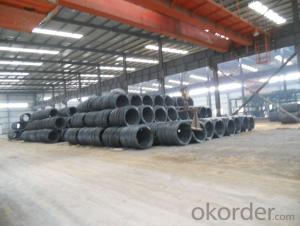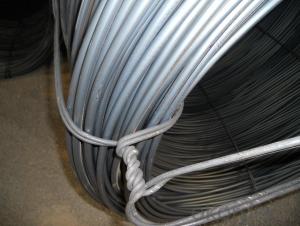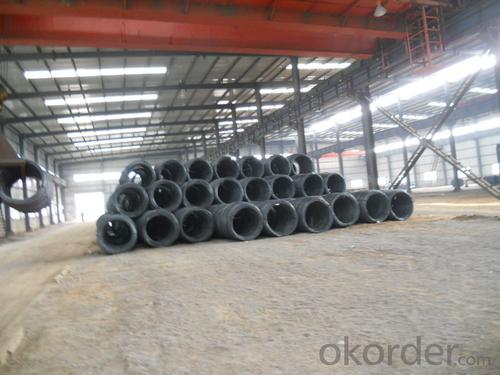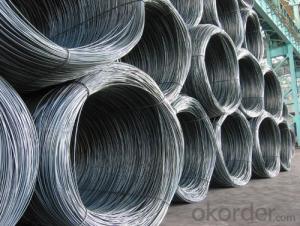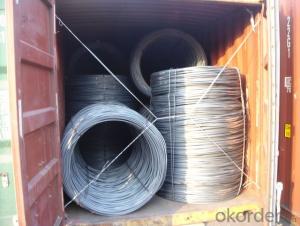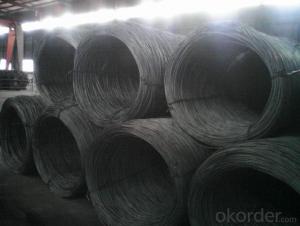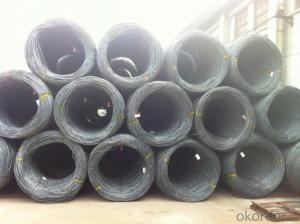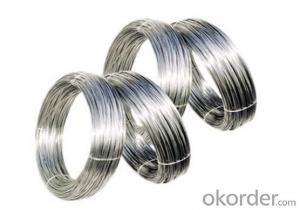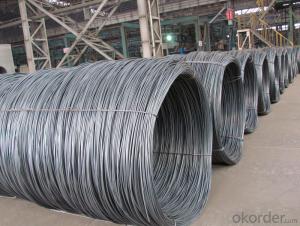Hot Rolled Steel Wire Rod SAE1006 SAE1008 SAE1018
- Loading Port:
- Tianjin
- Payment Terms:
- TT OR LC
- Min Order Qty:
- 500 m.t.
- Supply Capability:
- 40000 m.t./month
OKorder Service Pledge
OKorder Financial Service
You Might Also Like
Specification
Product Description:
OKorder is offering Hot Rolled Steel Wire Rod SAE1006 SAE1008 SAE1018 at great prices with worldwide shipping. Our supplier is a world-class manufacturer of steel, with our products utilized the world over. OKorder annually supplies products to European, North American and Asian markets. We provide quotations within 24 hours of receiving an inquiry and guarantee competitive prices.
Product Applications:
Hot Rolled Steel Wire Rod SAE1006 SAE1008 SAE1018 are ideal for structural applications and are widely used in the construction of buildings and bridges, and the manufacturing, petrochemical, and transportation industries.
Product Advantages:
OKorder's Hot Rolled Steel Wire Rod SAE1006 SAE1008 SAE1018 are durable, strong, and resist corrosion.
Main Product Features:
· Premium quality
· Prompt delivery & seaworthy packing (30 days after receiving deposit)
· Corrosion resistance
· Can be recycled and reused
· Mill test certification
· Professional Service
· Competitive pricing
Product Specifications:
Steel Grade: Q195/235, SAE1006-1018B Standard: ASTM, GB
Diameter: 5.5mm, 6.5mm, 7mm,8mm,9mm,10mm,12mm,14mm
Type: in coil, coil weight around 2MT Alloy or Not: Alloy
Technique: Hot Rolled Place of Origin: China Mainland
Surface: round, no twisted, light and smooth Brand Name: HSKY
Chemical Composition: (Please kindly find our chemistry of our material based on Q195、Q235A and Q235B as below for your information)
Trademark | Rank | Chemical composition (quality score) % | |||||
C | Si | Mn | S | P | |||
| ≤ |
| ≤ | ≤ | |||
Q195 |
| 0.06-0.12 | 0.30 | 0.25 | 0.050 | 0.045 | |
Q235 | A | 0.14-0.22 | 0.30 | 0.30-0.65 | 0.050 | 0.045 | |
Q235 | B | 0.12-0.20 | 0.30 | 0.30-0.70 | 0.045 | 0.045 | |
Usage and Applications of Wire Rod SAE1008B:
After hot-rolled the products shaped into coil and delivery as finished product, including round, square, rectangular, hexagonal and so on. Since most of the products are round, it is generally called wire rod. Carbon steel wire rod is widely used in construction and manufacturing. Carbon steel wire rod is mainly used for reinforcement of reinforced concrete and welded structure or reprocessed (roberts , nail, etc.) materials, especially used to produce wire drawing, welding electrode, nails, spring, electronic, precise machinery parts and so on.
FAQ:
Q1: Why buy Materials & Equipment from OKorder.com?
A1: All products offered byOKorder.com are carefully selected from China's most reliable manufacturing enterprises. Through its ISO certifications, OKorder.com adheres to the highest standards and a commitment to supply chain safety and customer satisfaction.
Q2: How do we guarantee the quality of our products?
A2: We have established an advanced quality management system which conducts strict quality tests at every step, from raw materials to the final product. At the same time, we provide extensive follow-up service assurances as required.
Q3: How soon can we receive the product after purchase?
A3: Within three days of placing an order, we will begin production. The specific shipping date is dependent upon international and government factors, but is typically 7 to 10 workdays.
Q4: What makes stainless steel stainless?
A4: Stainless steel must contain at least 10.5 % chromium. It is this element that reacts with the oxygen in the air to form a complex chrome-oxide surface layer that is invisible but strong enough to prevent further oxygen from "staining" (rusting) the surface. Higher levels of chromium and the addition of other alloying elements such as nickel and molybdenum enhance this surface layer and improve the corrosion resistance of the stainless material.
Q5: Can stainless steel rust?
A5: Stainless does not "rust" as you think of regular steel rusting with a red oxide on the surface that flakes off. If you see red rust it is probably due to some iron particles that have contaminated the surface of the stainless steel and it is these iron particles that are rusting. Look at the source of the rusting and see if you can remove it from the surface.
Images:


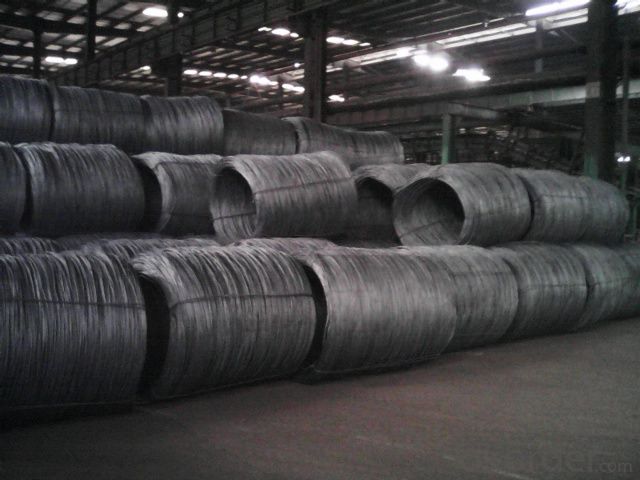
- Q: What are the main factors influencing the choice of steel wire rod after-sales service?
- The choice of steel wire rod after-sales service is influenced by several main factors. Firstly, the quality of the service provided plays a crucial role. Customers expect prompt and effective after-sales support, including timely response to inquiries, technical assistance, and problem resolution. A reliable after-sales service ensures customer satisfaction and builds trust in the supplier. Secondly, the availability and accessibility of spare parts and components are important considerations. If a customer encounters any issues with the steel wire rod, they would expect the supplier to have a readily available stock of spare parts to quickly address the problem. This minimizes downtime and ensures uninterrupted production. Additionally, the expertise and knowledge of the after-sales service team are critical factors. Customers value suppliers that have well-trained and experienced service technicians who can provide expert advice and guidance. This helps customers optimize the performance of the steel wire rod and address any operational challenges they may face. Another influential factor is the cost-effectiveness of the after-sales service. Customers look for service packages that offer value for money, including reasonable prices for spare parts, maintenance contracts, and repair services. A cost-effective after-sales service ensures that customers receive the necessary support without incurring significant additional expenses. Furthermore, the geographical coverage and response time of the after-sales service team are considered. Customers prefer suppliers with a wide service network, enabling them to receive support even in remote locations. Additionally, a fast response time is crucial to minimize production downtime and maintain efficient operations. Lastly, customer feedback and reputation also influence the choice of steel wire rod after-sales service. Positive testimonials and references from existing customers can instill confidence in potential buyers. Therefore, suppliers who consistently receive positive feedback and have a strong reputation for excellent after-sales service are more likely to be preferred. In conclusion, the main factors influencing the choice of steel wire rod after-sales service include the quality of service, availability of spare parts, expertise of the service team, cost-effectiveness, geographical coverage, and reputation. By considering these factors, customers can make an informed decision and choose a supplier that meets their after-sales service expectations.
- Q: What is the weight of a standard steel wire rod coil?
- The weight of a standard steel wire rod coil can vary depending on its diameter and length. However, a typical range for these coils is between 1,000 to 5,000 kilograms.
- Q: How is steel wire rod used in the production of wire shelves and racks?
- Steel wire rod is a critical raw material used in the production of wire shelves and racks. It is first formed into wires of specific diameters, which are then further processed through various shaping and welding techniques to create the desired shelf or rack designs. The steel wire rod provides the necessary strength and durability to withstand the weight of items placed on the shelves or racks, ensuring their structural integrity. Additionally, the wire rod's corrosion resistance properties make the shelves and racks suitable for both indoor and outdoor use.
- Q: How are steel wire rods used in the production of fishing lines for catching fish?
- Steel wire rods are a crucial component in the production of fishing lines for catching fish. These wire rods are used to create the core of the fishing line, providing strength and durability necessary to withstand the tension and pressure exerted by large fish during the catching process. To manufacture fishing lines, the steel wire rods undergo a series of processes. Firstly, the rods are drawn through a series of dies to reduce their diameter and increase their length. This process, known as wire drawing, results in thinner and longer wire rods, which are easier to handle and work with during the production of fishing lines. Once the wire rods are drawn, they are coated with a layer of protective material, such as nylon or polyethylene, to enhance their resistance to abrasion, UV rays, and water damage. This coating also improves the overall flexibility and knot strength of the line, making it more reliable for fishing purposes. After the coating process, the steel wire rods are then twisted or braided together to form the fishing line. The number of wire rods used and the specific twisting or braiding technique employed varies depending on the desired strength, thickness, and characteristics of the fishing line. The resulting fishing line is known for its exceptional strength, durability, and resistance to breakage. It can withstand the harsh conditions of fishing, such as sharp rocks, strong currents, and the thrashing of fish, without losing its integrity. This makes it an essential tool for anglers, enabling them to confidently target and catch a wide variety of fish species. In summary, steel wire rods are integral to the production of fishing lines as they provide the necessary strength and durability required for successful fish catching. The wire rods are drawn, coated, twisted, or braided together to create fishing lines that are strong, flexible, and resistant to the elements, allowing anglers to enjoy a reliable and efficient fishing experience.
- Q: What are the main challenges in recycling steel wire rod?
- Recycling steel wire rod presents several primary challenges. To begin with, the collection and sorting of steel wire rod pose a major obstacle. Steel wire rod exists in various forms and sizes, making it difficult to separate from other materials during recycling. Advanced sorting technologies and efficient collection systems are necessary to ensure that only steel wire rod is recycled and other materials are appropriately sorted. Another challenge arises from the presence of contaminants in steel wire rod. Coatings like zinc or other metals frequently accompany steel wire rod and must be removed before recycling. These coatings can impede the quality of the recycled steel and may necessitate additional processing steps to guarantee the purity of the final product. Additionally, recycling steel wire rod is energy-intensive. The melting process employed in recycling requires high temperatures and consumes a substantial amount of energy. This presents challenges in terms of both cost and environmental impact, as it contributes to greenhouse gas emissions and demands significant energy resources. Moreover, the transportation and logistics involved in recycling steel wire rod can be problematic. Steel wire rod is often bulky and heavy, leading to increased transportation costs and necessitating specialized equipment for handling and processing. The logistics of collecting, transporting, and storing steel wire rod for recycling can be intricate and require efficient coordination to ensure a smooth recycling process. Lastly, fluctuations in market demand for recycled steel wire rod can create challenges for recycling facilities. The demand for steel wire rod is influenced by economic conditions, construction activities, and infrastructure development. During periods of low market demand, recycling facilities may struggle to find buyers for their recycled steel wire rod, impacting the profitability and viability of the recycling process. In conclusion, the primary challenges in recycling steel wire rod encompass collection and sorting, removal of contaminants, energy consumption, transportation and logistics, and market demand fluctuations. Addressing these challenges necessitates technological advancements, efficient processes, and a strong market demand for recycled steel wire rod.
- Q: How is steel wire rod used in the manufacturing of screws and bolts?
- Steel wire rod is used in the manufacturing of screws and bolts as it serves as the primary raw material. The wire rod is first drawn into the desired diameter and then cut into specific lengths to create the base material for screws and bolts. This wire is then further processed through various manufacturing processes, including heading, threading, and heat treatment, to shape and strengthen it into the final product. So, steel wire rod is an essential component that provides the necessary strength and durability to screws and bolts.
- Q: What are the different types of steel wire rod coatings used for improved adhesion?
- Improved adhesion in steel wire rods can be achieved through various types of coatings. These coatings, applied to the surface of the wire rod, enhance its bonding properties with other materials or substances. Some commonly utilized coatings are: 1. Zinc Coatings: Galvanization is the process of applying zinc to the wire rod surface, widely used to improve adhesion. Zinc coatings form a protective layer, preventing corrosion and enhancing bonding capabilities. 2. Phosphate Coatings: Often used as a pre-treatment, phosphate coatings create a thin layer of phosphate crystals on the wire rod's surface. This enhances adhesion and provides a good base for subsequent coatings. 3. Polymer Coatings: Polymer coatings, such as epoxy, polyurethane, or polyester, are a popular choice for improving adhesion. Applied as a thin layer, they offer excellent bonding properties and protect against corrosion. 4. Epoxy Coatings: Known for exceptional adhesion, epoxy coatings are applied as a two-part system, combining epoxy resin with a hardener. They provide resistance to chemicals, abrasion, and corrosion, making them suitable for various applications. 5. Nylon Coatings: Nylon coatings are ideal for wire rods requiring high durability and resistance to wear and tear. These coatings offer excellent adhesion and possess good mechanical properties, finding applications in industries like automotive and construction. 6. Ceramic Coatings: Ceramic coatings excel in adhesion and resistance to high temperatures. They are commonly used in wire rods exposed to extreme heat or requiring enhanced thermal properties. When selecting a coating for improved adhesion in steel wire rods, it is crucial to consider specific application requirements and environmental conditions. Each coating type has its own advantages and limitations, and choosing the right one significantly impacts the wire rod's overall performance and longevity.
- Q: How are steel wire rods used in the production of screws and bolts for construction?
- Steel wire rods are used in the production of screws and bolts for construction as they serve as the raw material for manufacturing these fasteners. Steel wire rods are first heated and then drawn into the desired diameter and length to create the wire that is used to form the threads of screws and bolts. These wires are then cut, shaped, and threaded to create the final product. The high strength and durability of steel wire rods make them ideal for construction applications, ensuring that the resulting screws and bolts can securely hold structures together.
- Q: What are the common applications of pre-stressed and oil tempered steel wire rod?
- Pre-stressed steel wire rod is commonly used in construction and engineering applications, such as for pre-tensioning or post-tensioning of concrete structures, bridges, and high-rise buildings. It helps to improve the load-bearing capacity, durability, and overall structural integrity of these projects. On the other hand, oil tempered steel wire rod is frequently utilized in the manufacturing of springs, suspension systems, and other high-stress applications. Its unique properties, obtained through the tempering process, provide excellent resistance to fatigue and ensure reliable performance in demanding industries such as automotive, aerospace, and machinery.
- Q: How is steel wire rod classified based on its strength?
- Steel wire rod is classified based on its strength by referring to its yield strength, which is the maximum amount of stress a material can withstand before it starts to deform permanently. This classification helps determine the suitability of the wire rod for various applications, with higher strength wire rods being used in applications requiring greater load-bearing capacity.
Send your message to us
Hot Rolled Steel Wire Rod SAE1006 SAE1008 SAE1018
- Loading Port:
- Tianjin
- Payment Terms:
- TT OR LC
- Min Order Qty:
- 500 m.t.
- Supply Capability:
- 40000 m.t./month
OKorder Service Pledge
OKorder Financial Service
Similar products
Hot products
Hot Searches
Related keywords

